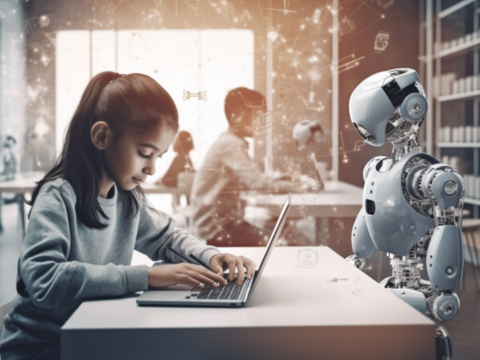One of the most significant impacts of Artificial Intelligence (AI) in education is its ability to provide personalized learning experiences. Traditional education systems often follow a one-size-fits-all approach, which can leave some students behind while others are not sufficiently challenged. AI addresses this by analyzing data on students’ learning styles, strengths, and weaknesses, and then tailoring educational content to meet individual needs. For instance, AI-powered platforms like intelligent tutoring systems adapt to a student’s pace, offering extra practice where needed or advancing when a concept is mastered. This personalized approach ensures that students learn at their own pace, leading to better engagement and understanding.
AI plays a central role in enabling personalized learning by analyzing vast amounts of data to understand each student’s strengths, weaknesses, learning styles, and preferences.
The following are key ways in which AI supports personalized learning:
1. Adaptive Learning Platforms
AI-driven adaptive learning platforms are designed to adjust the difficulty level of tasks based on a student’s performance in real-time. These platforms continuously monitor how students interact with educational content, identifying areas where they excel or struggle. For example, if a student consistently struggles with a particular math concept, the AI system can provide additional resources, exercises, or even alter the teaching approach to help the student better understand the topic. Conversely, if a student shows mastery of a concept, the system can advance them to more challenging material, ensuring they remain engaged and challenged.
2. Personalized Learning Paths
AI can create individualized learning paths that guide students through a curriculum based on their unique learning needs. These paths consider a student’s prior knowledge, learning speed, and preferred learning style. For instance, some students might benefit more from visual aids, while others may prefer textual explanations or hands-on activities. AI systems can recommend the most suitable resources, such as videos, interactive simulations, or reading materials, to match each student’s learning preferences.
3. Real-Time Feedback and Assessment
AI-powered tools can provide real-time feedback to students, helping them understand their mistakes and learn from them immediately. Unlike traditional assessment methods that may take days or weeks to deliver results, AI systems can analyze student responses instantly, offering detailed explanations and suggesting areas for improvement. This immediate feedback loop allows students to adjust their learning strategies on the fly, leading to more effective and efficient learning.
4. Learning Analytics
AI-driven learning analytics provide educators with deep insights into student progress and behavior. By analyzing data on how students interact with educational content, AI can identify patterns and trends that may not be immediately apparent to teachers. For example, AI can highlight which topics students are finding most challenging, enabling educators to provide targeted interventions or adjust the curriculum as needed. This data-driven approach allows for more informed decision-making and ensures that instruction is tailored to meet the needs of each student.
5. Intelligent Tutoring Systems
Intelligent Tutoring Systems (ITS) are AI-based tools that simulate one-on-one tutoring by providing personalized instruction and support. These systems use AI to understand a student’s learning needs and offer tailored explanations, hints, and feedback. ITS can also adapt to the student’s learning pace and provide a more interactive and engaging learning experience. For instance, an ITS might guide a student through a complex problem by breaking it down into smaller, more manageable steps, offering encouragement and support along the way.
6. Language Processing and Learning Support
AI can also support personalized learning by assisting with language processing, making education more accessible to students with different language backgrounds. For example, AI-powered translation tools can convert educational content into various languages, helping non-native speakers understand the material better. Additionally, AI-driven speech recognition and text-to-speech tools can support students with disabilities, ensuring that personalized learning is inclusive and accessible to all.
BENEFITS OF PERSONALIZED LEARNING THROUGH AI
1. Enhanced Engagement: By tailoring content to individual interests and learning styles, AI helps keep students engaged and motivated.
2. Improved Learning Outcomes: Personalized learning paths ensure that students are neither bored by material that is too easy nor overwhelmed by content that is too difficult.
3. Efficiency: AI-driven personalization allows students to progress at their own pace, which can lead to faster mastery of concepts and more efficient use of learning time.
4. Support for Diverse Learning Needs: AI can cater to a wide range of learning preferences and abilities, making education more inclusive and equitable.
CHALLENGES AND CONSIDERATIONS
While the potential of AI-driven personalized learning is vast, there are challenges to consider. These include ensuring data privacy, avoiding bias in AI algorithms, providing equitable access to AI tools, and maintaining the role of human interaction in education. Balancing these factors is crucial to maximizing the benefits of personalized learning while minimizing potential risks.
CONCLUSION
Personalized learning through AI represents a significant shift in education, offering tailored learning experiences that can greatly enhance student engagement and outcomes. By leveraging AI’s capabilities to adapt to individual learning needs, educators can create more effective and inclusive learning environments.
However, to fully realize the potential of AI in personalized learning, it is essential to address the associated challenges and ensure that AI is implemented thoughtfully and responsibly.

